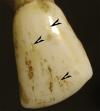

2. Page Marker
4. Seals
5. Rowels
8. Tweezers
9. Pricker
10. Leads
11. Quill Pens
12. Four-flanged Pen
13. Stylus
14. Penners
15. Firelighter Iron
16. Tooth Burnisher
17. Medieval Inks
18. Lead Inkwell
19. Inkhorn
Title Tooth Burnisher


Brief description This is the only recorded existing example of a Bovid Tooth Burnisher from the 14th or 15th century used as a burnisher for gilding. The tooth is specifically a lower left incisor of a Bos Taurus, a now–extinct domestic cow. The root of the tooth has been shaved to fit into a handle which was probably wooden. Very few of the tools used in gilding have been recovered to the archeological record. The tooth bears marks consistent with modification into a burnisher with wear marks and traces of gold leaf from years of illumination. The broad side of the tooth with its tough enamel would have proven to be well–suited to burnishing large areas of gold. The smaller sides would have been optimal for smaller sections of guilding as more control and precision would have been optimal. [Paraphrased from Alan Cole’s notes.] Alan Cole gives this account of his encounter with the object: “Many of the took commonly used in book production in the later Middle Ages have proved remarkably elusive in the archaeological record. Thousands of extant manuscript pages are decorated with gold leaf, yet no examples of the tools used in gilding have been reported. An exception is a bovid tooth in the collections of the Museum of Writing (London). The tooth bears marks consonant with modification as a burnisher, appropriate wear marks and traces of gold leaf. The object was first recorded in association with other scribal tools.” Copyright 2006 Alan E. Cole, Randall Rosenfeld and the Society of Antiquaries of London. Thus begins the paper on this object in the Society of Antiquaries of London Journal, Number 86 of 2006 written by Randall Rosenfeld of the Pontifical Institute of Medieval Studies, Toronto and myself. The full sixteen page paper can be read in the afore–mentioned publication, of which this is a very brief synopsis. Like all good stories, it began whilst searching for a woman—my fianc&eaigu;e at the time. I had gone down to the New Forest in 1974 to see her, without real success, and went to an antiques fair in Ringwood, Hampshire, to pass the time. I was particularly looking for writing examples, as usual, and got talking to an antiques dealer, Brian Edwards, who was also buying such items. During lunch at a local pub, he said that he had some things that might interest me. He had a bag from which he took a wooden box in which were a wooden handled punctorium/stylus, a worn thick leather case (penner) containing two badly deteriorated quills, an inkhorn, a corroded blade (presumably a quill knife), the tooth in a very worn leather pouch large enough to accommodate it when fitted to its no longer extant handle, some finely-twisted gut strings attached by pegs to a rectangular piece of wood scored with two sets of lines and Rowel 3 (see Prickers and Rowels), a copper-alloy cross and three pilgrim's tokens of lead. Edwards said that the box and contents had been purchased the day before from a Charles Morton of Hampshire, in whose family it had been for many generations. According to the family records that they were 'spoils from an abbey'. To cut a very long story short, Edwards was not willing to part with any of the items, apart from the rowel and the tooth, said by Edwards to be a horse’s tooth, as ‘they have nothing to do with writing or the other contents’. After some years, when I was first re–cataloguing my collection, I again became interested in the tooth, as I always had that collector’s tingle whenever I handled it. Accordingly, I took it to the British Museum, as they had the widest variety of objects. A curator said that it could be a horse’s tooth, but he was no expert in that field, then he suddenly sat up and asked if I had realised that there were traces of gold in some of the striations. I had not looked that closely, but I had noticed his next comment, that the root had been shaped as though to fit a handle, probably wooden. He took it away and discussed it with other colleagues and concluded that it might have been worn as an amulet covered in gold, but most likely, ‘it could have been used as a burnisher in view of the areas of gold flecks’. Naturally, this really got my pulse racing and my next visit was to the British Library where I got the same response about the use as a burnisher and from the Victoria and Albert Museum. Each of which said that there was no record of one being extant. In 2004, I went to the Natural History Museum in London to try and ascertain the exact source of the tooth. After much research, the answer was that it was the lower left first incisor from a medieval Bos Taurus, an extinct, domestic cow or ox.
Contributor: Stella Castillo and notes from Alan Cole
Contribution date: Winter 2014